Sean McBride's Blog, page 13
June 3, 2021
Blind Read Through: H.P. Lovecraft/August Derleth; The Fisherman of Falcon Point
 The town of Falcon Point
The town of Falcon Point“Dr. Gilman kept his own council, but the two who had brought him whispered into one ear after another a singular tale, telling how they had found in the house a great moisture, a wetness clinging to the walls, to the doorknob, even to the bed to which they had lowered Enoch Conger only a short while before hastening for the doctor – and on the floor a line of wet footprints made by feet with webbed toes – a trail that led out of the house and down to the edge of the sea, and all along the way the imprints were deep, as if something heavy had been carried from the house, something as heavy as Enoch.“
Welcome back to another Blind Read! This week we’re treading familiar “waters” as we get a quaint little story, which potentially created echoes throughout literary history.
The Fisherman of Falcon Point is pretty much exactly what you would think it is. It’s a story about a fisherman in the little burg of Falcon Point which is just down the coast from the infamous Innsmouth.
The story begins as a fairy tale: “Along the Massachusetts coats where he lived many things are whispered about Enoch Conger-” Enoch is the main character (I hesitate to say protagonist) of the story, and in this first line we immediately get the understanding that something strange is going on with him; he’s become a legend people tell, but Derleth does a good job in the opening of not indicating if he survived or otherwise, thus increasing our curiosity as a reader. He even goes one step further later down the page: “There he lived until he was seen no more, for none can say he died.”
Our narrator tells us “He was a powerful man, broad in the shoulders, barrel-chested, with long, muscular arms.” Also “…that he talked with the gulls and terns, with the wind and the pounding sea, and with others that could not be seen and were heard only in strange tones like the muted sounds made by great batrachian beasts unknown in the bogs and marshes of the mainland.”
Conger was a loner, a taciturn man who we’re made to believe speaks to animals because he’s so solitary. He only interacts with humans when he heads to the bar after coming in from a fishing excursion; it’s when he’s fishing in the sea just off the coast of Falcon Point and Innsmouth in which he communes with the fishes. Better than sleeping with the fishes I guess!
What’s important about the introduction of the story is the tone and method of telling the tale. Derleth usually takes a bit of a closer 3rd person perspective in his writing, giving us a glimpse into what the character themselves are thinking. This story moves back to a more 3rd omniscient perspective, with slightly more whimsical language. The effect is that instead of this story feeling like a driving short horror, it reads more like a mythology/world building story. It truly feels like you’re sitting around the campfire while Derleth tells you this fantastical tale…
Which is important because the story threads the line based upon what we guess about the area and the established mythology of the area. You never feel as though Conger is in mortal peril, but you know something very strange is about to happen to him.
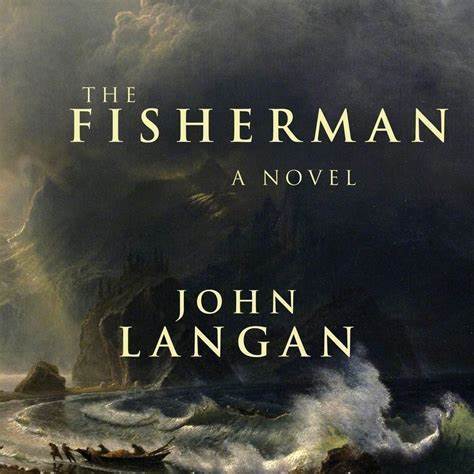
In fact the tone and style of this story remind me so much of a more recent literary horror novel, “The Fisherman” by John Langan. You can ignore what seems to be the connection between these tales, because what it really is, is the fantastic mythology based around location. “The Fisherman” is highly recommended if you’ve not partaken, but it proves that though Lovecraft created this world, none of his writing had this tone or whimsy. This is purely Derleth creating a legacy.
Anyway back to the story. Conger spends much of his time in his favorite spot fishing, until that spot finally dries up, so he decides to venture out further… out towards Devils Reef in the sea beyond Innsmouth. Once there he “cast his net, and brought up many fishes – and something more-“
That something more is never described, but it spooks Conger enough to immediately leave. He heads back to his favorite bar where he tells his fishy tales, and the aged fishermen there think he’s seen a mermaid. “She was not a mermaid.” Conger responds, but is only met with derision.
 she was not a mermaid
she was not a mermaid“They laughed at him and made many a jest, but he heard them not.” But still he was spooked. He stayed away from Devil’s Reef for years and eventually, “…one night the word was brought to Innsmouth that Enoch Conger had been greviously hurt at his lonley occupation...” where two local fisherman took him back to his home and left him there to find the doctor.
We get the opening quote of this essay next as Enoch is carried away. At this point, based upon what we know about Enoch we can assume one of two things. He either had DNA from Innsmouth in his blood somewhere along the lines because of his penchant to speaking to animals, especially amphibians, or he was in some way marked by the cult of Dagon to be taken.
Years later “the venerable old Jedidiah Harper, patriarch of the coastal fishermen,” swore that he saw a school of fishlike people swimming alongside his boat. The had the look of half amphibian and half man, “they had seemed to be singing a chant to Dagon, a chant of praise, and among them, he swore, he had seen Enoch Conger…“
This raises a dark and fascinating point in which Derleth is playing at. I mentioned back in the Blind Read for “The Shadow out of Space” that Derleth seemed to be playing with body horror, or the idea that someone could be altered physically as well as mentally because of an outside force. In that story it was an Elder Sign on a person. Here we actually have Conger transitioning from a human into a Deep One and it seems as though he was marked early on. Namely his penchant for speaking to animals and then his catching a Deep One in a net. It’s possible that original Deep One he caught did something to him which started the transition, and it was only years later that he began his transformation, but I rather think it was the “injury” he sustained when found by those two fisherman. I think he was more than likely altered in some way, by his own volition or not, and that event caused the transition. He wasn’t actually injured. He was forced to change by some ritual.
 was the creature from the black lagoon a Deep One?
was the creature from the black lagoon a Deep One?We’ve talked about it before: rituals are a cornerstone with the Lovecraft mythos. Much of what goes on in Lovecraft’s original work is actually called (by his own verbiage) witch craft. That hasn’t happened very much so far in Derleth’s tales, but with this story, we may just be turning a corner.
Join me next week as we explore “Witch’s Hollow.”
Post Script:
As an aside, the first few stories in Derleth’s collection had Saurian, or Reptilian creatures who prayed to Dagon. The last few all had Batrachian, or amphibian creatures. Both of these are a bit of a divergence, from the fish men that were the Deep Ones in Lovecraft, but Derleth’s Amphibious creatures are a much closer distinction than the reptilian. I wonder if we’ll ever get a reason for this in the text, though I tend to believe there wont be. It may just be Derleth’s poetic license that he felt he could do whatever he wanted with the legacy, or it’s possible that he didn’t truly understand his friend’s writing before he started himself. In any case, I’m excited to see where we go next!
May 27, 2021
Blind Read Through: H.P. Lovecraft/August Derleth; The Shuttered Room

“That was what his grandfather had meant when he had written ‘you have gone forth into the world and gathered to yourself learning sufficient to permit you to look upon all things with an inquiring mind ridden neither by the superstition of ignorance nor the superstition of science.'”
Welcome back to another Blind Read! Here we have a combined sequel to both “The Shadow Over Innsmouth” and “The Dunwich Horror” all at the same time. If you don’t think those stories jive too well together you’d be right; one is about Dagon and the other about Yog-Sothoth. It seems, however, as though Derleth decided that he liked Cthulhu and Dagon (the fishy ones) so much more that he’d focus all of his energies on slowly phasing out of Lovecraft’s Yog-Sothothery and into his own more popular Cthulhu Mythos.
We begin the tale talking about the backwoods of Massachusetts and I was immediately excited: “At dusk, the wild, lonely country guarding the approaches to the village of Dunwich in north central Massachusetts seems more desolate and forbidding than it ever does by day.”

The Dunwich Horror is one of my favorite Lovecraft tales because he packs so much into it and not only is it a wonderful horror tale, but it also expands his mythos in such a wonderful way. The Whatley’s are farming folk and Lavinia Whately, a strange albino woman, becomes pregnant. No one seems to know who the father is, but mad old Whately mentions in passing about some strange theory that she was impregnated by someone named Yog-Sothoth, but that’s just in passing, and he’s crazy anyway, so we move forward. Lavinia gives birth to Wilbur, who is strange in and of himself, he ages prematurely, he’s described as a “dark, goatish infant,” he has an odd musty odor, and under the tutilage of old man Whateley he’s drawn to Arkham to study the Necronomicon. While at Miskatonic University he turns into a beast and dies, but the doctors are curious as to how that’s possible so they head to Dunwich to investigate, only to come across a terrible Shoggoth as it rampages across the country side.
 Depiction of Lavinia Whatley
Depiction of Lavinia WhatleyThat is as simple an explanation as I can give, but the story is significantly better. In Derleth’s tale the only real connection to Dunwich is the Whately name. Our protagonist is Abner Whately which is confusing because in the original tale we’re led to believe the line of Whately’s died off. We’re given a brief description: “The Whatleys has a curse on ’em…and thar’s what happened on Sentinel Hill that time-Lavinny’s Wilbur” but that isn’t really a connection. We can only assume that there were cousins to the branch that died off in Lovecraft’s tale living somewhere nearby and took over the farmhouse. That new Whatley, Grandfather Luther as named in this new story, had a few children. Our protagonist Abner meets Zebulon, his uncle and speaks of his Aunt Sarah, who their grandfather Luther locked away in her room after she visited…wait for it…Innsmouth.
At the mention of Innsmouth we lose all thread of Dunwich and suddenly the story becomes a sequel to Lovecraft’s doomed “Shadow Over Innsmouth” instead.
You might ask why Sarah decided to go to Innsmouth? Well Derleth hashes that reasoning out in dialog:
“‘What was Aunt Sarah doing in Innsmouth?‘
‘Visitin’ kin.‘
‘Are there Whatleys there, too?’
‘Not Whatleys. Marshes. Old Obed Marsh that was Pa’s cousin.‘”
If you remember from “The Shadow Over Innsmouth” Old Obed Marsh was a sea captain who took a strange island wife whom was not seen much afterward. She was, in fact, one of Dagon’s Deep Ones; a fish creature who worships from the underwater city just off Devil’s reef off the coast of Innsmouth called Y’ha-nthlei. Innsmouth itself was peopled by hybrid Deep Ones, as the people of that coastal town were breeding with the Deep Ones for years.
 Depiction of Deep ones
Depiction of Deep onesAnd that’s what happened to Sarah. She met her cousin Ralsa Marsh and apparently had a tryst. When Grandfather Luther heard of it, he locked her away in her room.
So we’ve been weaving back and forth between stories, but lets focus on what happens in Derleth’s, shall we? The reason Abner arrived at the house is because his Grandfather Luther died and asked him to go there and burn down the mill and everything above it. In his letter, Luther tells Abner “It is my wish that at least the mill section of this house be destroyed. Let it be taken apart, board by board. If anything in it lives, I adjure you solemnly to kill it. No matter how small it may be.”
Then there is a post script, “If I seem to have the sound of madness, pray recall that worse than madness has spawned among the Whatelys. I have stood free of it. It has not been so of all that is mine. There is more stubborn madness in those who are unwilling to believe in what that know not of and deny that such exists, than in those of our blood who have been guilty of terrible practices, and blasphemy against God, and worse.”
If you blink you miss it. Obviously Luther is speaking of his daughter Sarah here. She’s the one touched by madness, because she had an affair with her fishy Deep One cousin, Ralsa. She’s the one whom was locked in the room, presumably with her offspring…locked in there until she died.
But that isn’t what could be missed in that paragraph. Lovecraft was very careful to God out of his works. Actually that’s probably a mis-statement. He didn’t believe in god…or the devil. So Lovecraft’s horror was cosmic, because in his world there wasn’t truly evil, there was only incomprehensible horrors. Derleth, conversely, was very religious and he mentions God in nearly every story I’ve read so far. That’s not necessarily a bad thing…well it is if you’re a Lovecraft fan…but what he seems to be saying here is that because Sarah was “guilty of terrible practices” namely having sex with her cousin, that she was rightly entombed with her spawn. It is meant, I’m sure, to mean that because Ralsa was a Deep One and Sarah’s judgment was so poor that she hooked up with him, that had to be kept safe from herself. The issue seems to be Derleth’s however because he’s the one who made Ralsa her cousin. There’s no precedence for that in Lovecraft, so its almost like it’s Derleth made him a cousin because in his’s eyes, sex with your cousin is the same as being an evil otherworldly creature. Not saying it’s right, but it sure doesn’t warrant a death sentence.
 family of Deep Ones
family of Deep OnesSo Abner is there to destroy the room and the mill. He goes about the story working to do this task, and while doing so heads to Sarah’s room. To get rid of the musty smell he “...kicked the shutters out to let in a welcome blast of fresh, damp air.” When he turns to inspect the room he “caught sight of a long-legged frog or toad” vanish behind a bureau. What we come to realize is that Sarah’s and Ralsa’s offspring was full Deep One and apparently in Derleth’s part of this shared universe when Deep Ones don’t eat they become diminutive. Abner’s act of kicking out the shutter, gives the creature a chance to escape. The dead cattle? That’s the escaped Deep One eating and growing to regular size. If you remember from “The Dunwich Horror” this is what the Shoggoth did, so much so that the old man Whatley and Wilbur had to keep rebuilding farmhouses to house it.
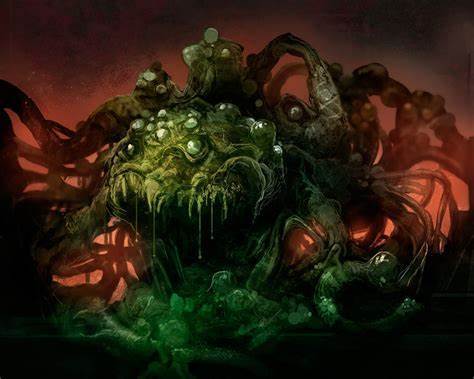 Depiction of a Shoggoth
Depiction of a ShoggothBut Abner doesn’t realize this at first. It isn’t until Abner heads to the shuttered room late in the story and sees “There, squatting in the midst of the tumbled bedding from the long-abandoned bed, sat a monstrous, leathery skinned creature that was neither frog nor man, one gorged with food, with blood still slavering from it’s batrachian jaws and upon it’s webbed fingers…” with limbs “grown from its bestial body like those of a frog, and tapering off into a man’s hands, save for the webbing between the fingers.“
He throws the lantern at the creature, immolating both it and the room, thus ending the horror.
Derleth tries to include some aspects of “The Dunwich Horror” into this tale, but he makes small changes. The odor which pervades the story is fishy instead of musty, the dead cattle are because a Deep One is on the loose instead of a Shoggoth. He uses tools like this to bring his tale together and separate himself from Lovecraft. He obviously wants things to be more connected with Cthulhu, potentially making that eldritch god a much larger aspect of the whole mythos…but then again he’s stepping on his own toes.

A few weeks ago we covered a few stories, Namely “The Peabody Heritage” and even further back “The Survivor.” In both of these stories the creature whom we can only understand as an aspect of Dagon or Cthulhu, were Saurian, I.E. reptilian. However in this story he seems to be changing that to batrachian, or fishlike, amphibian. Why is he changing up his own rules between stories? Could there be a connector I haven’t seen yet? Could Derleth be trying to connect more of the world and make it cohesive for all his new readers? By the title we have a great read next week to find out!
Join me as we dive into “The Fisherman of Falcon Point!”
Derleth is cherry picking to fulfill the needs of his current tale.(The ancestor, the peabody heritage)
May 20, 2021
Blind Read Through: H.P. Lovecraft/ August Derleth; The Shadow Out of Space
 Rendition of Yog-Sothoth
Rendition of Yog-Sothoth“If it is true that man lives forever on the edge of an abyss, the certainly most men must experience moments of awareness – of a kind of precognition, as it were – when the vast, unplumbed depths which exist forever on the rim of man’s little world become for one cataclysmic moment tangible, when the terrible, boundless well of knowledge of which even the most brilliant man has only tasted, assumes a shadowy being capable of striking the most primal terror into even the stoutest heart.”
Welcome back to another Blind Read! This week we trudge through the terribly derivative and bastardizing story, while reconciling memory and looking to the future of Lovecraft Country.
Right from the beginning of this story, I could tell that it was going to be a weak retelling of “The Shadow Out of Time” and unfortunately it was nearly a word for word reconditioning of that odd novella with Derleth putting his own, less sophisticated stamp on it. Derleth tries to clarify what was going on in the original story, but unfortunately the whole thing just leaves a bad taste in your mouth, as he strives to tie some of the mythos together, which don’t seem as though they fit.

It’s ultimately a lazy effort and pretty obviously a money grab. Even the title, replacing Space or Time, is a lazy effort to reimagine. Reading this story almost feels like I’m reading “Lovecraft for Dummies”, which is a massive let down.
There are some interesting connectors though, and that’s what we’ll be focusing on as I give you a Cliffs Notes version of the story.
If you’ve read “The Shadow out of Time” you know what’s going to happen. This story follows Nathaniel Corey who’s our narrator. Corey has a patient, Amos Piper, who had the same kind of strange circumstances of his alliterative counter part Peaslee from “The Shadow out of Time.” They black out for years, loosing that time. They suddenly developed an interest in the occult while they concurrently lose control of their bodily faculties for a period of time. It turns out in both stories that the characters were invaded by one of the Great Race of Yith, a race looking to gather information about every other species in existence. The Yith have the ability to travel through time and space (hence both titles) to do so. Eventually the Yith retract, and the more the narrator digs, they eventually find themselves being invaded.

What Derleth’s version is missing is the philosophical element of Lovecraft’s novelette. In fact it seems like that’s what he’s missing with all of his stories. Lovecraft has popularity because he created incredible atmosphere, but at the same time, his stories were philosophical treatises. Derleth, I’m coming to understand, is basically writing dime store books. He’s actively removing the philosophy from Lovecraft’s ethos and dumbing the stories down to make them more accessible to a wider audience. The jury is still out about how I feel about this, especially because he seems to change small things about the stories which I think curve away from the original intent (more specifically creating a more Christian outlook instead of an apathetic one). The only real philosophizing in this story is the opening quote of this essay, which incidentally is the opening paragraph (or at least most of the opening paragraph) of the story.
That being said Derleth does add a few details to make this world more his own. Some of these add a layer of sub-context which both inform us of Derleth’s process and add a bit to the story. The first of these comes fairly early in the story and had me excited for the prospects:
“The moment I close my eyes, there appear on the retina strange geometrical figures and designs, together with vague lights and even more sinister shapes beyond, as of great creatures past the conception of mankind...”
If we remember from stories such as “Dreams in the Witch House” and even such favorites as “The Call of Cthulhu,” strange geometrical figures and angles play a huge role. In Lovecraft they’re used as a sort of talisman to help magnify the magic being used. Strange angles, conversely, seem to create a fold in space and time where dimension and time hopping becomes possible. Derleth seems to be layering this concept onto people. If we can actually put these designs onto our own figure, can we call forth elder entities into our own bodies? Would they come through us in some kind of body horror, or would they merely take over our minds which seems to be indicated here in this story? It’s a very exciting prospect for what could possibly be coming in later stories.

Derleth also makes use of popular culture as well, grounding the story into a specific timeline. Piper’s episode of transmogrification takes place during a performance of Somerset Maugham’s “The Letter.” Because this reference was so specifically called out it makes me wonder if there’s a specific meaning behind it’s inclusion. “The Letter” is about a woman named Leslie, who is on trial for killing Geoff Hammond, a friend of her husbands. Throughout the play it’s found out that Hammond was in fact Leslie’s lover, who scorned her for another woman. The eponymous letter comes to light and Leslie is eventually acquitted, but she’s not completely innocent. She is guilty of adultery and sees her punishment as the knowledge that she killed the man she truly loved.
On surface level this seems like it doesn’t connect. What could this possibly mean? I contemplated for a few pages until I came across a long quote which begins to reveal a potential deeper meaning:
“The rugose cones which made their present form had been occupied for only a few centuries, and were far from their true form, which was more kin to a shaft of light, for they were a race of free minds, capable of invading any body and displacing the mind which inhabited it. They had occupied Earth until they had become involved in the titanic struggle between the Elder Gods and the Ancient Ones for the dominion of the cosmos, a struggle which, he told me, accounted for the Christian Mythos among mankind, for the simple minds of early men had conceived of their ancestral memories of this struggle as one between elemental Good and elemental Evil.”
There’s a decent amount to unravel here, but I want to add one more quote before we take the deep dive into Derleth’s mind.
“Indeed, if anything, his memory during his illness – once indoctrination had been completed – was infinitely superior to the functioning of that part of his mind before.”
So how does this correlate to “The Letter?” Follow with me here, because we’re getting deep!
 a beautifully philosophical tale. If you haven’t, click here to read “The White Ship”
a beautifully philosophical tale. If you haven’t, click here to read “The White Ship”Lovecraft made sure to keep religion out of his stories (although I do find an interesting correlation to heaven or hell in “The White Ship“), but it seems as though Derleth is working to incorporate and explain why it’s necessary. Lovecraft’s Yog-Sothothery was mostly apathetic; they were ancient and powerful gods who saw humans as insignificant. They weren’t “evil,” their goal was not to overthrow our society or make us slaves. We are as pointless as little black ants to them. If we annoy them they step on us. If we don’t bother them they generally let us be.
Derleth flat out states that it was a “struggle between elemental Good and elemental Evil.” He’s working to quintessentially change what Lovecraft was striving to do. He’s working to make it his own instead of honoring Howard. He gets away with it, making these tales more popular posthumously than during Lovecraft’s life, but he steals some of the heart of the tale. Derleth is Leslie. He’s ostensibly killed the memory of what Lovecraft was striving for, but he gets away with it, tarnishing the one he admired and loved.
That’s what this story feels like. It’s told well and it’s a interesting story, but only if you haven’t read Lovecraft first. If you had it feels like a tarnishing of the legacy. In Derleth’s effort to make it easier and more accessible, to put meaning behind why the Ancient Ones and the Elder Gods did what they did, makes the story somehow not really worth it. It’s the theory behind “the reveal.” If you have a monster so horrible that a mere glance at it could drive you insane, then you let the imagination come up with it’s image. Derleth, puts a rugose cone head and some tentacles and claws and calls it scary, when in reality, he’s just making it basic.
Let’s see how Derleth moves beyond this next week as we cover one of his most popular stories “The Shuttered Room”
May 13, 2021
Blind Read Through: H.P. Lovecraft/ August Derleth; The Lamp of Alhazred

Addendum: I was supposed to publish an essay on “The Shadow out of Space,” but I hit a computer blip. Luckily I’m headed out of town and worked ahead, and had this one ready a week early. Enjoy this one now and come back for “The Shadow out of Space” next week!
“The city on the desert was the Nameless City and the snowy peaks were the Mountains of Madness or perhaps Kadath in the Cold Waste. And he enjoyed keenly bestowing names upon these landscapes, for they came to him with ease, they sprang to his mind as if they had always been lingering on the perimeter of his thoughts, waiting for this moment to come into being.”
Welcome back to another Blind Read! This week we relax, awash in a wonderfully metafictional story, which is probably the most enjoyable Derleth tale to date!
I assumed by the title that this story would be about the cannon. The Mad Arab Abdul Alhazred is mentioned in a number of Lovecraft stories as the author of the original Necronomicon. A grimoire discussing the Elder Gods and the spells in which he was privy to. To both summon them, to honor them, and to worship them. He supposedly had an “otherworldly experience” and gained the knowledge of the Elder Gods, enough at least to write the cursed Necronomicon.
 “Mad” Abdul Alhazred
“Mad” Abdul AlhazredAlhazred was not mentioned beyond this capacity (at lest in Lovecraft’s works), but we can infer that he was one of the first “Dreamers” much like Randolph Carter (From such famous stories as “Through the Gates of the Silver Key,” “The Statement Of Randoph Carter,” and “The Dream-Quest of Unknown Kadath.”), however unlike Carter it seems as though either gaining the knowledge, or the act of writing the Necronomicon is what drove Alhazred “Mad.”
This story doesn’t have anything to do with Alhazred however, but is instead a homage to Howard Phillips himself. The story follows Ward Phillips, “then thirty, and in indifferent health, though this was but a continuation of the sickliness which had so often made his childhood miserable.”
After reading this passage on the first page I assumed Derleth was going to make the character a mirror Howard, but as I got deeper, I realized that Ward Phillips was just a stand in so he wouldn’t have to specifically mention Lovecraft. The story is a love letter to a lost friendship, and it was wonderful to experience. It is actually about Howard Phillips Lovecraft.
Derleth goes on to examine the man, “Phillips had become a writer for the pulp magazines, and had eked out a spare living by undertaking in addition the revision of countless almost hopeless manuscripts of prose and verse by writers far more amateur than he...” and “Phillips, who lived in the past, believed that the way to defeat the sense of time was to cling close to unaltered early haunts.” This is just another clue. We know what Derleth’s saying here is true from their correspondence and all such stories such as “The Horror at Red Hook.“
 Howard’s old view from the actual Nentaconhaunt hill
Howard’s old view from the actual Nentaconhaunt hill“He often went to a hill, Nentaconhaunt, from the slope of which he could look down on his native city and wait there for the sunset and the enchanting panoramas of the city springing to its life by night, with the steeples and gambrel roofs darkening upon the orange and crimson...”
This hill which the fictional Ward Phillips went to to gain inspiration from, is a real hill in Providence. The description in the above quote obviously lends to the atmosphere of Lovecraft’s stories in general and I wonder if Lovecraft himself spent time on that hill, taking in the evening and letting his imagination soar. Just how many stories obtained their genesis from time on that hill? The Hill’s name strikes me as well. I’m not sure of the etymology, and this isn’t the place to have that discussion anyway, but it seems to me that it enflamed Lovecraft’s dark imagination, perhaps even fueling the creation of such names as the “Necronomicon?”
In any case, Ward Phillips, our illustrious stand in, spends his evenings on the hill, so he spends his nights writing. He’s got a “meager income” so he doesn’t use electric light to write, but instead decides to use an old lamp his Grandfather Whipple left him (If that name sounds familiar you are correct. It is concurrently the name of Howard’s Grandfather, and Captain Abraham Whipple who led a charge against Joseph Curwen in “The Case of Charles Dexter Ward). The Lamp of Alhazred.
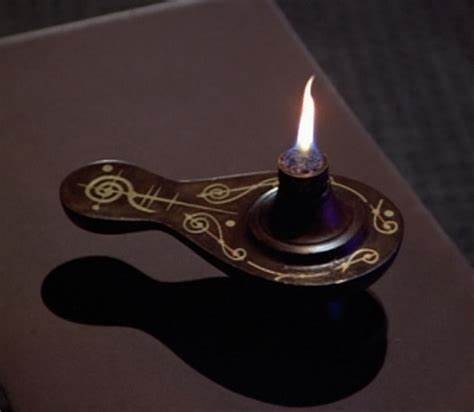 Rendition of the Lamp of Alhazred
Rendition of the Lamp of AlhazredI immediately thought the lamp was going to summon some kind of Deep One, but I was given a much more pleasant surprise. The lamp created a shadow play upon the walls, something “Ward” sat back and viewed in wonder:
“It seemed to be a scene of the earth when young, one in which the land was still in the process of being formed, a land where great gouts of steam came from fissures and rocks, and the trails of serpentine animals showed plainly in the mud. High overhead flew great beasts that fought and tore, and from an opening in a rock on the edge of the sea, a tremendous animal appendage, resembling a tentacle, uncoiled sinuously and menacingly into the red, wan sunlight of that day, like a creature of some fantastic fiction.“
“Slowly the scene changed,” into what the opening quote describes, and we realize that this story is not a horror story at all, but a homage, or even love song, between one author and his predecessor. There is care as Derleth even describes: “he took time to answer letters from his correspondents, to whom he wrote of his ‘dreams’.” which of course he’s speaking of himself as one of Lovecraft’s correspondents.
Derleth waxes poetic about how many people must have viewed the fantastic themes and scenes which came from the lamp and wonders how many will in the future. It’s at this point, just a page or two from the end, in which we realize he’s now speaking on Lovecraft’s writing. H.P.’s stories are, not just a candle in the dark, but a lamp, illuminating a new way forward for authors. He made it possible to move beyond Gothic horror and try new things. He was the trail-blazer who created a dynasty of such authors as Robert Bloch and Robert E. Howard, and informed artists such as Moebius and H.R. Giger.
[image error] Other than the Xenomorph from “Aliens”, one of Giger’s most popular pieces.It’s a fantastic little story and it brought me back to the first day I started this blog series. What it must have been like to be one of his pen pals. To hear of the story ideas, and to bath in the blossoming fungi that became his oeuvre. I can only hope that the rest of the stories in Derleth’s collection live up to the same inspiration!
Join me next week as we look into “The Shuttered Room”
May 6, 2021
Blind Read Through: H.P. Lovecraft/August Derleth; The Ancestor
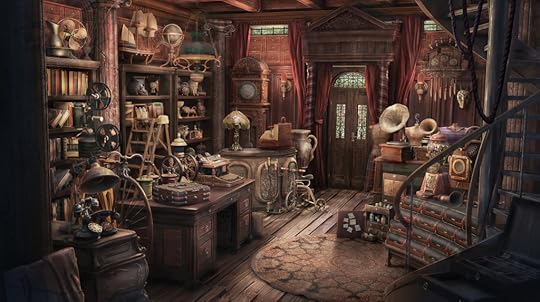
“There was no question but that my cousin had found some way to tap the stream of memory; he had established beyond doubt that everything that happened to a human being was registered in some compartment of the brain, and that it needed but the proper bridge to it’s place of storage in memory to bring it to consciousness once more.”
Welcome back to another Blind Read! This week we travel back into time alongside Derleth’s characters to view a fairly Lovecraftian Tale, which quixotically, doesn’t hold enough of Lovecraft’s themes.
Here’s another tale told in Vermont and (at least as far as I could tell) is absent of any of Derleth’s predilections of adding in little details like names of old characters to get readers excited, but instead holds to the trope of a man in trouble calling on a friend to help them in their research as Lovecraft did in tales such as “The Whisperer in Darkness” and “The Colour out of Space.”
We begin with a description of the man in need, the narrator’s cousin, Ambrose Perry. He’s apparently an old retired medical doctor whom “went into virtual seclusion at his home, which he had built in the middle of a dense wood, and outfitted with as complete a laboratory as money could buy.”
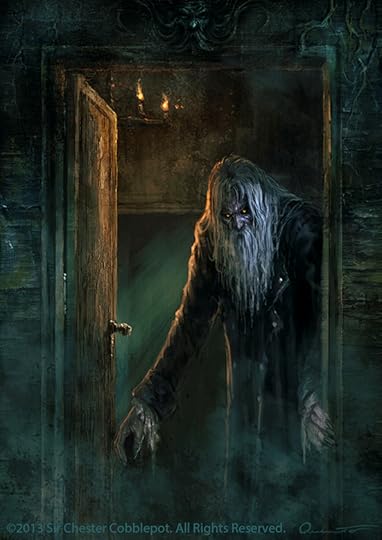
Ambrose calls on our narrator, a man who’s without a job. Ambrose sends him a letter, “offering me a handsome emolument if I would accept the position of secrecy.” A theme which was not, I believe, intended was the unreliable narrator trope. The narrator is a man who’s probably in his mid to late thirties and jobless without prospect. This tale was written in the fifties, so the idea of a man of that age without prospects generally leads me to the idea that the narrator is a vagrant, and is possible of anything if he thinks it will get him a little further… or possibly to get another fix (more on that later)? The two men are cousins that’s true, but why would the narrator be reached out to first? And why the emphasis on the importance of secrecy? Probably because vagrancy lends itself to being disposable, so it wouldn’t matter the secrets learned, because the narrator was never meant to leave the property. Something to think about as we move throughout the story.
Why was this the first thing that came to my mind? Because when Ambrose answers the door, “he was thin and gaunt; the hale, ruddy man I had last seen almost four years ago had vanished, and in his place stood a mere travesty of his former self.” Ambrose had come across something profound. He either wanted someone who wouldn’t say anything because they understood, or he wanted someone disposable when things got too deep.
Ambrose brings the narrator into confidence and tells him the job is to transpose his notes from shorthand into a narrative, then proceeds to tell our narrator that he’s developed a method of, “a combination of drugs and music, taken at a time when the body is half-starved induces the mood and makes it possible to cast back in time and sharpen all the faculties to such a degree that memory is regained.” The point of this vision quest is to “recapture all my past, down to the most minute nooks and crannies of human memory, and I am now further convinced that, by the same methods, I can extend this perceptive process to hereditary memory and recreate the events of man’s heredity.” He’s even said that he’s recaptured memories from his own time in the womb.
The narrator lives in this strange abode for weeks with his host disappearing for half of every day to do his strange experiments. His only companionship are the Reeds, “man and wife, who were both in their sixties, were subdued. They made little conversation, not only because Mrs. Reed both cooked and served her dinner, but because they were plainly accustomed to carrying on an existence apart from their employer’s…”
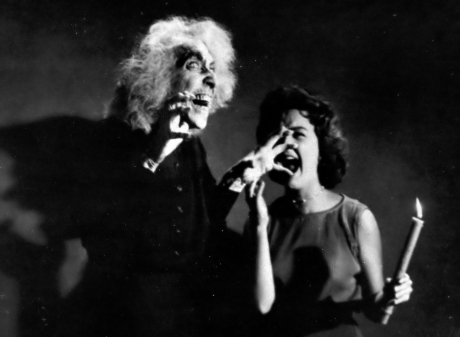 The creepy but innocuous Mrs. Slydes
The creepy but innocuous Mrs. SlydesWhy is the only thing he mentions the fact that she cooks him dinner? Why doesn’t he mention the butlery duties of Mr. Reed? Initially this would seem like it’s an important designation. In fact I wrote in my notes that they were characters to watch. I thought they might be devious, possibly nefarious characters, but they turn out to be just an old couple who have seen too much and decide they just need to put their heads down and do their job. In fact they turn out to be much like The Slydes from “House on Haunted Hill.” They’re atmosphere. They’re not really characters, but a backdrop to give off a creepy vibe.
So the atmosphere is in place and the narrator is curious about what’s going on, until finally Ambrose grows to weak from his food abstinence. He calls the narrator in and we finally get a glimpse. “The atmosphere of the laboratory, ill-lit with but one low red light near to the operating table, was eerie. My cousin looked far more like a corpse than a man under the influence of drugs. Moreover, there was playing in one corner an electric phonograph, so that the low, discordant strains of Stravinsky’s Le Sacre du Printemps flowed through the room and took possession of it.“
 Stravinsky’s dark classic
Stravinsky’s dark classicThis is an area of prose where Derleth is sound. His writing is simplistic and over-run with contextual errors (not to mention lazy. There’s a part of me that after reading Lovecraft for years and bathing in his beautiful exposition, to be laden with Derleth just outright saying “it was eerie” is a bit troublesome), but he gives off a much more visual contextualization. It’s almost as though because Derleth wrote after TV became popular and Lovecraft didn’t, that his tales are more direct…as though they’re stories meant to read like a show, rather than Lovecraft who was more cerebral. It’s an interesting juxtaposition, but it’s probably not the right time for that.
Getting back to the story, the narrator is now privy to the lab and takes notes of Ambrose going even further back in time, back to before he was born in fact, back to memories that couldn’t possibly be his own and eventually he broke into the strangest of phrases:
“Forest sunk into earth…Great ones fighting, tearing. Run, run… New trees for old. Footprints ten feet across. We live in cave, cold, damp, fire…“
Ambrose thinks he may have gotten somewhere, but strangely, he kicks our narrator out. He locks the door leaving the Reeds and the narrator to wait outside and listen to the odd sounds coming from the laboratory. Ambrose’s dog starts to get upset; “Whereas hitherto he had been a singularly well-behaved dog, now he began to bark often at night, and day by day he whined and moved about the house and yard with an air of alarm.”
They would leave food on a tray outside of the laboratory door, and always when they weren’t looking the food would disappear. The notes became more difficult for the narrator to decipher. “He seemed to have difficulty properly holding a pencil, and his lines were scrawled in large letters over all the sheets of paper without any sense of order, though this was not entirely unexpected in one heavily dosed with drugs.”
But then the music, what Ambrose touted as heavily important for the process, suddenly stopped right about the time, “a pervasive and highly repellent musk, clearly an animal odor, which seemed to emanate from the laboratory.” The narrator also thinks he “...saw some unpleasantly large animal scuttling into the woods.“
The narrator finally gets into the lab and finds what to him looks like “a primal animal’s abode.” With parts of game, obviously caught and devoured strewn about the lab. The lab itself was destroyed, but the door leading to the woods was wide open.
The narrator followed the trail until he came upon Ginger, Ambrose’s dog, with a fresh kill in the woods:
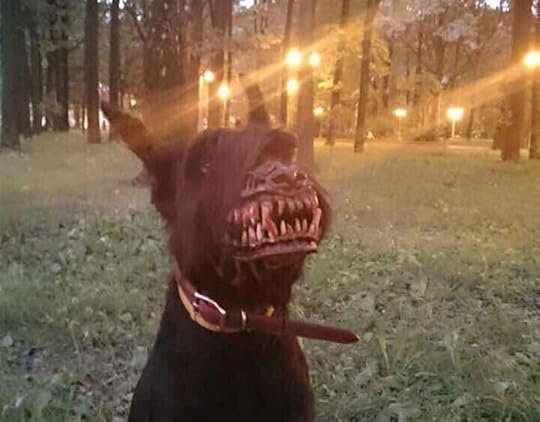
“For the thing that lay below Ginger’s bloody jaws was a sub-human caricature of a man, a hellish parody of primal growth, with horrible malformations of face and body, giving off an all-pervasive and wholly charnel musk – but it was clad in the rags of my cousin’s mouse-colored dressing-gown, and it wore on it’s wrist my cousin’s watch.”
So we come to find that the set up of the story had a Lovecraftian tint; a man searching for knowledge, taking part in obscure or arcane rituals, but the payoff is different than anticipated. He goes back in time and because of the rituals he executed, he gained aspects of his prehistoric ancestors. It’s a shocking ending sure, but Derleth lost quite a bit along the way. There was plenty of drama he could have infused with Ambrose looking like his actual ancestors, much like in “The Case of Charles Dexter Ward.” There’s also the mention of the Great Ones, which didn’t actually pan out.
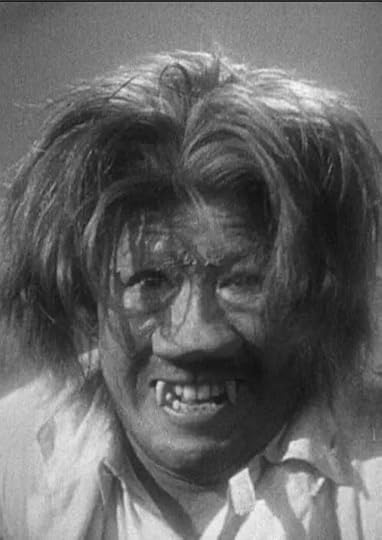 What Ambrose would have looked like in a Universal Horror flick.
What Ambrose would have looked like in a Universal Horror flick.Ultimately the story reads much like the narrator is…unreliable. I mentioned earlier that the narrator was a confusing personage. Is he a man looking to do the most and just down on his luck? It doesn’t seem so because of all the previous things mentioned, and also his vast knowledge of drugs. There’s a portion of the text where the narrator gives a scientific description of the Marijuana Ambrose “uses.” I’ve seen this in people I know, where they are so enamored with Weed that they get into the scientific aspects of it, sometimes to the detriment of everything else in their lives. Could that be what the narrator was looking for? Easy access to weed?
Even if that is the case, he’s unreliable. What’s more Derleth is unreliable as well and I’m slowly coming to the understanding that there may be a metafictional dichotomy here. Derleth was using Lovecraft’s name to sell his horror fiction and where… yes… he coined the phrase “Cthulhu Mythos” and supposedly expanded Lovecraft’s world, it feels like he’s using key words of Lovecraft to get some of his weirder tales out there.
Derleth himself is unreliable because I keep going into these stories expecting a Lovecraftian payoff, but he pulls the rug out from under us just as we get to the end. Is this how the rest of the experience will go? Fun stories, but not nearly Lovecraftian? Based on the title I think we’re going to find out next week!
Read along as we cover “The Shadow out of Space!”
April 29, 2021
Blind Read Through: H.P. Lovecraft/August Derleth; The Gable Window
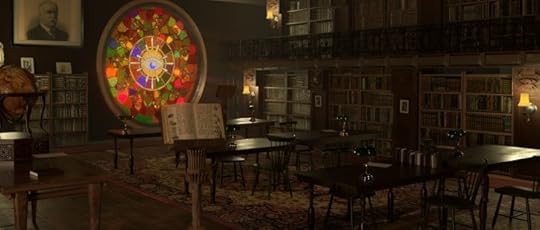
“Though the majority of these alterations had apparently been made to contribute to Wilbur’s comfort, there was one change which had baffled me at the time that Wilbur had made it, and for which he never offered any explanation; this was the installation in the south wall of his gable room of a great round window of a most curious clouded glass, of which he said only that it was a work of great antiquity, which he had discovered and acquired in the course of his travels in Asia. He referred to it as one time as “the glass from Leng” and at another as “possibly Hyadean in origin,” neither of which enlightened me in the slightest…“
Welcome back to another Blind Read! This week we delve into Derleth’s most cosmic story yet, while at the same time lamenting his tone and applauding his action.
From the very start “The Gable Window” feels like Derleth stretched to make it much more of a Lovecraft story than it is. His Christianity is just so profound that it pervades the writing in such a way that you instantly know it isn’t Howard Phillips, but at the same time, the text is good enough to make you want to keep reading.
The story starts off with two slaps in the face which are meant to be fan service. About half way down the first paragraph we get this:
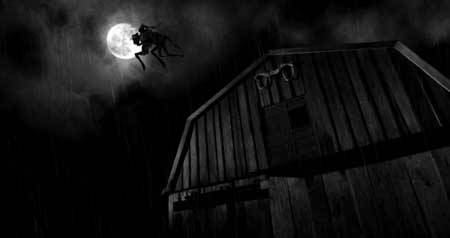 From a horror/humor iteration of “The Whisperer in Darkness”
From a horror/humor iteration of “The Whisperer in Darkness”“It (the house of the narrator’s cousin, Wilber Akeley) had fallen into disuse after the grandson of the farmer who had built it had left the soil for the seaside city of Kingston, and my cousin bought the estate of that heir disgruntled with the meager living to be made on that sadly depleted land. It was not a calculated move, for the Akeleys did nothing by sudden impulse.”
Instantly I’m annoyed. As we’ve seen from previous stories, Derleth has no qualms with using names and locations of Lovecraft’s to disuse. Akeley is the name of the farmer whom communes with, and takes rides from, strange advanced aliens in “The Whisperer in Darkness,” but this turns out to be ok, because Wilber (later in the story) is a relative of Henry, which instantly ties this story into Lovecraft country. Why then, did Derleth decide to call the seaside town Kingston instead of Kingsport? It cheapens the story, making it seem as though Derleth either tried to make the story his own, or even worse, that he accidentally called the city by the incorrect name. These kind of iniquities keep popping up throughout Derleth’s stories, and it’s no wonder there’s disdain for him using Lovecraft’s name. It’s not the stories themselves, which are entertaining, but that he lends fan service while at the same time not actually continuing the traditions. Kind of like why Fans of Star Wars are so upset with the most recent trilogy of movies.
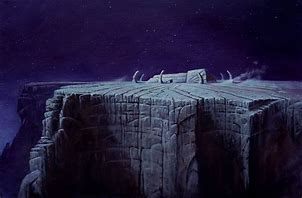 Illustration of the Plateau of Leng
Illustration of the Plateau of LengGetting back to the story, the narrator renovates the house, much like the narrator did in “The Peabody Heritage,” but as we see in the introductory quote to this essay, he doesn’t remove or remodel the glass in the gable window. The Plateau of Leng is popular in Lovecraft literature as both an alien landscape and a space in Antarctica where reality is thin and the ability to dimension hop is strong (foreshadowing alert), seen in such stories as “At The Mountains of Madness” and “The Dream-Quest of Unknown Kadath” and where it seems a strange and dangerous place, it isn’t nefarious at all.
The room is obviously the most used, but “I found myself from the beginning curiously repelled by the gable room, in part certainly because it reminded me so strongly of the living presence of my dead cousin who could never again occupy his favorite corner of the house, in part also because the room was to me unnaturally alien and seemed cold to me, holding me off as by some physical force I could not understand…“
The room is filled with Wilbur’s manuscripts and various books from the nearby Miskatonic University in Arkham, which we know from Lovecraft is one of the few locations which house the fabled Necronomicon.
 From the Fabled Necronomicon
From the Fabled NecronomiconThe narrator hears various noises. “These were of no consequence at first: they began as tiny, almost unnoticed things.” Like what sounded like a cat scratch at the window, or some kind of slapping/slithering sound coming from the window. It didn’t unnerve the narrator until he realized there was no possible was for a cat to touch the window and there was no tree nearby.
Unnerved but nonplussed, the narrator continues his renovations and eventually gets a letter from the executor of the estate stating that all Wilbur’s papers on his research are to be destroyed, the books on certain shelves are to be turned into Miskatonic University, and the glass in the gable window broken.
Interested, the narrator goes to these shelves and finds strange and old books; “The more recent ones among them – and none of these dated beyond 1850 – had been assembled from various places; some had belonged to our fathers’ cousin, Henry Akeley, of Vermont, who had sent them down to Wilbur; some bore the ownership stamps of the Biblotheque Nationale of Paris…”
Here is where I get touchy. There are things like this throughout Derleth and despite the fact that he lauds himself as an incredible writer (without a doubt these stories are fun), he make a plethora of mistakes. This whole story Wilber is our narrator’s cousin. This quote all of the sudden makes him the narrators brother? “…some had belonged to our fathers’ cousin…” The narrator and the cousin couldn’t have the same father or they wouldn’t be cousins. These are the little missteps which happen again and again that directly contradict other details in Derleth’s stories. This is also why I believe that he didn’t mean to misquote Kingsport as Kingston, he just didn’t care to go back through and verify the details. It’s just sloppy writing, and NOT something which Lovecraft would have permitted considering his perfidy.
Moving beyond the irritation, the Biblotheque Nationale of Paris is the second known location of the Necronomicon, and in the very next paragraph we get a small list of books contained within this auspicious home library:
“…they bore such titles as Pnakotic Manuscripts, the R’lyeh Text, the Unaussprechlichen Kulten of von Junzt, the Book of Eibon, the Dhol Chants, the Seven Cryptical Books of Hsan, Ludvig Prinn’s De Vermis Mysteriis, the Celaeno Fragments, the Cultes De Goules of the Comte d’Erlette, the Book of Dzyan, a photostat copy of the Necronomicon…“
This is all very exciting because here Derleth infuses some of his own ideas seamlessly into Lovecraft (meaning some of these books are of Derleth’s creation), but then unfortunately in the next sentence he ruins the progress he makes:
“Did it matter whether you call it God and the Devil, or the Elder Gods and the Ancient Ones, Good and Evil or such names as the Nodens, Lord of the Great Abyss, the only named Elder God, or these of the Great Old Ones…“
Derleth then goes on to name the Lovecraftian Pantheon which is his strength. He is the one who really clarified the mythos and created it as we know it today, but yes August, it really does matter if you call it God and the Devil.
Lovecraft created a world which was amoral and apathetic. The Ancient Ones and the Elder Gods had their own agendas and humans just tend to get in the way at times, as we strive for more power. In the Lovecraft world the only good and evil was man…and nearly always it was man who was evil. In our apparent struggle for power we are the ones who create menace; these Elder Gods are merely like a giant rock in the road. If we just pass them by we might not even know they’re there, but if we get curious and want to know what they are and accidentally kick them, we break our toe.
Derleth frames his religion overtop of this uncaring world gives good and evil attributes to them. All the sudden these creatures who were never malevolent, just massive (think of yourself walking down the street and accidentally stepping on a bug), are all the sudden a hidden threat bent on killing off or enslaving mankind. The issue is, that kind of creature belies the genius of Lovecraft. If the Elder Gods are evil, then humankind should have been wiped out all together because these Elder Gods are just too powerful. In Derleth’s world, these Elder Gods once ran the universe but are now waiting for some fool to blunder into setting them free, or some cult to summon them back to their glory. In Lovecraft these creatures were unknowable which made the merest glance of them drive a man insane. In Derleth’s stories they become a land dwelling octopus.
There are very few tentacles in Lovecraft. There are many tentacles in Derleth.
And we see them as the narrator goes into the room with the gable window. For the first time he notices there’s a pentagram drawn on the ground. Curious he decides to read off some text:
“Ph’nglui mglw’nafh Cthulhu R’lyeh wgahnagl fhtagn.”
and suddenly the glass becomes a portal and he seems strange baked landscape with odd people he remembers his cousin calling Sand People. Then from a cave:

“…little by little, an incredible monster made it’s appearance – at first a probing tentacle, then another, and presently half a dozen cautiously exploring the caves mouth. And then, from out the darkness of the cavern’s well, an eldritch head shown dimly.”
The creature moves forward to the glass…eventually through the glass and the narrator is terrorized. Yet unlike in Lovecraft where the narrator would lose consciousness only to then delve into a downward spiral of madness, this narrator comes to his senses and wipes the side of the chalked Pentagram, instantly closing the portal. How do we know it worked?
“…I know beyond doubt that what I saw was not the product of my feverish fancy, because nothing could demolish that final damning proof which I found near the shattered glass on the floor of the gable room – the cut tentacle, ten feet in length, which had been caught between dimensions when the door had been shut against that monstrous body to which it belonged, the tentacle no living savant could identify as belonging to any known creature, living or dead, on the face or in the subterrene depths of the earth!“
Despite all the issues I’ve laid out, it’s a very satisfying tale. I point these things out so that the casual reader will know the difference between what the experience is between reading Lovecraft and Derleth. Will these disparities continue?
Let’s find out next week as we read “The Ancestor.”
April 22, 2021
Blind Read Through: H.P. Lovecraft/August Derleth; The Peabody Heritage
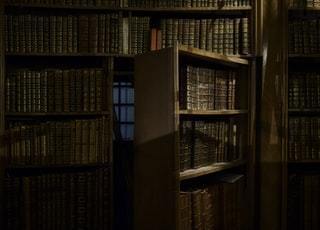
“For at the base of the wall, behind the baseboard, there lay, among long yellowed papers half gnawed away by mice, yet still bearing on their surfaces the unmistakably cabalistic designs of some bygone day, among wicked implements of death and destruction – short, dagger-like knives rusted by what must surely have been blood – the small skulls and bones of at least three children!“
Welcome back to another Blind Read! This week we’re unraveling Derleth’s complex love of Lovecraft while trying to understand his religious overtones thrust upon the conversely amoral Lovecraft Universe.
The first note I feel I have to hit is the overarching hope in Derleth’s horror. This is now the third story I’ve read by him and all the while there has been a niggling itch that I just couldn’t reach. These types of stories could have been written by Lovecraft, but there is something so utterly different about them and until now I just couldn’t put my finger on it. The language is slightly different, but for a reader who is only looking for story and isn’t going to dig any deeper, I’m not sure if they would notice a difference. The stories themselves are absolutely horror with fantastic elements, and similar terrifying hopeless situations the protagonists find themselves in. So what is it?
There is a subtle nearly imperceptible change. Lovecraft was depressed and that comes off in his writing style. The characters are dreary, people stuck in cycles of destitution and despair. Nearly every story has an overwhelming feeling of hopelessness.
In Derleth’s stories (thus far at least) the protagonists not only survive, but they aren’t thrust into a horrid spiral of depression and fear. It’s much more light hearted as if they’re stories told by a college buddy over drinks about an escapade, rather than a drunk recounting the horrors that led him to the bottom of the bottle to a bartender in some run down dive.
That’s an extreme statement but the sentiment is real. Lovecraft is serious, his tales have bite and nuance, whereas Derleth’s stories seem to be written more for fun.
That being said, let’s check out what fun can be had in The Peabody Heritage!
It starts out with an immediate reference to the old Lovecraft tales, “I never knew my great-grandfather Asaph Peabody…” If you’ll remember from Lovecraft’s story “In the Vault” there’s a character named Asaph (known for his angry, bucolic disposition) who’s buried in a tomb. There are things that happen in that story which echo this one, and unfortunately I knew within that first sentence what was basically going to happen at the end of this one…but more on that later.
 The fabulously strange Winchester Mystery House
The fabulously strange Winchester Mystery HouseThe first chapter is about the protagonist slowly moving back into his ancestral home. It’s a fascinating description which recalls the Winchester Mystery House in San Jose, CA: “The dwelling itself was the product of many generations. It had been built originally in 1787, at first as a simple colonial house, with severe lines, an unfinished second storey, and four impressive pillars at the front. But, in time, this had become the basic part of the house, the heart, as it were. Subsequent generations had altered and added to it-at first by the addition of a floating stairway and a second storey; then by various ells and wings…”
This is a wonderful way to introduce the detective story the tale becomes as the narrator works to renovate this house so that he can live in it. He even finds the family tomb and enters it, curious about his lineage. He finds various cubbies and caskets in the tomb with the names of his family etched upon them, but then he finds Asaph’s disturbed tomb:
“Moreover, it seemed as if someone had lifted or attempted to lift the cover, for one of the hinges was broken, and the other loosened.”
Curious as to what happened he lifted the cover and, “I saw that through some hideous error, he (Asaph) had been buried face downward – I did not want to think, even at so long a time after his death, that the old man might have been buried in a cataleptic state and so suffered a painful death in that cramped, airless space.“
It’s a strange thought with the evidence of the tampered sarcophagus lid to go immediately to the idea he may be buried alive, but seemingly because of this sentiment he flips the skeleton over before putting the lid back on the coffin. Derleth handles this with deft skill because altering the remains is obviously thematically dangerous, but the way it’s written feels almost as if it’s done with a religious reverence instead of a horrible precognition.
The next chapter begins with our narrator dreaming, a theme which continues along though the entire story that connects to a major Lovecraftian concept – dreaming. The question immediately is, what does dreaming mean to Derleth? As we’ve talked about in previous Blind Reads, Lovecraft seems to consider dreaming as travelling or dimension hopping. So many of his stories held the precedent that the “dreamers” like Randolph Carter were actually time travelers who went through gates of consciousness and dimension to instantly find different areas of time and space. Derleth, starts down that road, but then seems to take a different approach here.
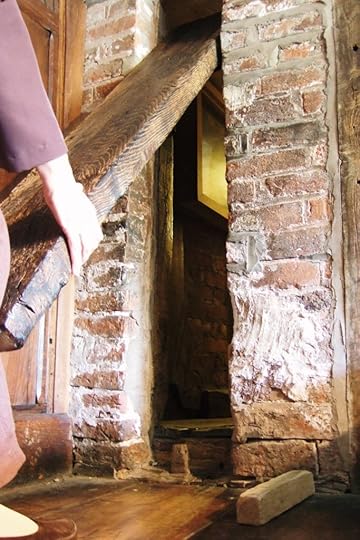 A priests hole
A priests holeAfter finding what they consider a “priests hole” (a place to hide runaway slaves) in one of the strange void spaces in the house, the narrator, “Though ordinarily not at all given to dreams, I was literally beset by the most grotesque phantasms of sleep, in which I played a passive role and was subjected to all manner of distortions of time and space, sensory illusions, and several frightening glimpses of a shadowy figure in a conical black hat with an equally shadowy creature by his side.“
So initially this seems to indicate that because of the “distortions of time and space” that we might be getting some of that dimensional hopping, but as we get deeper into the tale we find that there is a distinct difference between dreaming and possession.
The protagonist goes into “…a space unaccounted for along the north wall upstairs, in the oldest part of the house” and found “The door to it (was) hidden in the finely-wrought carvings which decorated that entire wall,” and that “…the door which had no knob and worked only by pressure upon one of the carvings.”
I mean who doesn’t want a secret office which has a secret door with a pressure plate lock carved into a cedar relief on a wall? It’s still a dream of mine!
They go into this room and found, “...it’s angles seemed to be awry,” and there “…were curious drawings on the floor.” and all manner of strange texts (including such gems as the Malleus Maleficarum) and news stories of missing children.

Having read through Lovecraft we know instantly that this is a witches room. The odd angles, much like in “Dreams of the Witch House” and other stories, are there because they present a bend in the fabric of reality and make witchcraft easier to practice; spells more potent. The fact that there are stories of missing children lend a malevolence to the room.
Intrigued our narrator continues doing work on the house and begins having more and more prevalent dreams of this Black Man (as in color not race) and his nefarious familiar. The narrator heads to town and finds that the townsfolk are despairing of him, though he tries to be friendly. When he inquires as to their demeanor, he’s told that his family name, Peabody, has a terrible history. His ancestors were thought to have stolen children whom they killed to be used in some kind of witchcraft.
Discouraged, he goes home but finally gets a construction crew to go through that secret wall and renovate the hidden office. Through the construction he dreams of Walpurgis night (which, if you remember from Lovecraft, that’s a night of witchcraft) where he walks through the woods to a Black Mass out in the woods. There’s a group of witches along with his Black Man and large black cat which stands beside him. When the narrator wakens, he finds that his feet and legs are dirty.
 Depiction of Walpurgis Night
Depiction of Walpurgis NightSeemingly ignoring this outlandish event, he finds that the crew renovating have fled the house in disgust. When he goes to investigate, he come across the quote at the beginning of this essay. Panicked, he takes the children’s remains and puts them into one of his ancestors coffins. Then to make matters worse, three more children go missing.
And still he dreams. His somnambulant excursions take him back to the Black Mass again and again, and there’s some strange Christian iconography there which was always absent in Lovecraft. We hear of the devils, Balor, Beelzebub, and Sathanus. While Lovecraft went a long way to divest himself from any kind of religious deities, Derleth is leaning into them, seemingly in an effort to add horror from these Christian call backs.
We also find that these Devils are trying to bring him into the fold of their coven and that these nightly excursions are actually happening, they aren’t actual dreams. This is a theme that we’ve seen in “The Case of Charles Dexter Ward” as well, where an ancestor of a character begins to take over the living relative because they accidentally took part in reviving the ancestor. We get confirmation of this when the narrator goes to the crypt and checks on Asaph’s grave and finds that the bones have begun to grow skin, and there are three bodies of children in the coffin with Asaph’s remains!
 Fantasy depiction of Balor
Fantasy depiction of BalorAnd here is that call back from earlier. Remember when I said we’d see how the story ended? in the tale “In the Vault” Asaph was a corpse who came alive and tried to kill one the characters of that tale. Asaph as corpse bit into his leg and tried to make him fall to his death on the stone ground. In this story, the disturbed body is what actually causes the Demon Balor to come back, as turning him over reinstated the machinations of the Devils.
The fact is that the narrator wasn’t dreaming, but because he turned the body over, he allowed Asaph to come into his body and use it to go to the Black Mass. It was possession, not dreaming.
So in the end we have the narrator fighting these forces and wondering, “Who, I wonder, after I am dead, if I am buried as the others were, will turn me over?”
Initially this seems like a dark and twisty ending, but in reality Derleth just leaned into it. Lovecraft would have had the narrator telling us how he went insane, how he fought and did everything he could to stop the coven, and whether he succeeded or not he would have been irrevocably changed. The tone would have been much more desolate.
Here Derleth’s character just gives in and decides he wont fight. That he will just take part of the coven with the Devils and do their bidding. It’s a dark ending, but in a weird way it’s not as dark as Lovecraft would have been, because at least here the narrator has hope that he will live on, though in a twisted way. Lovecraft’s character wouldn’t have wanted to live on, because of the strange and utterly devastating knowledge he had gained.
Will all Derleth be this way? Join me next week with “The Gable Window” to find out!
April 15, 2021
Blind Read Through: H.P. Lovecraft/August Derleth; Wentworth’s Day
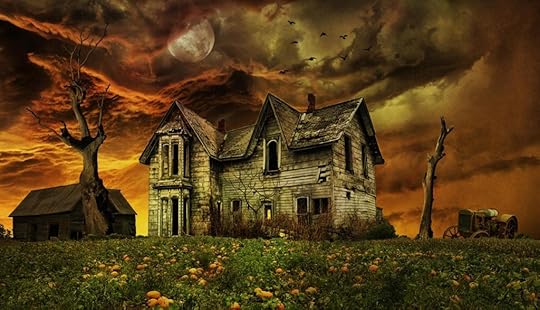
“I assured him I had never heard of Nahum Wentworth before, though I admitted privately to some curiosity about the object of my host’s preoccupation, insofar as he had been given to reading the Seventh Book of Moses, which was a kind of Bible for the supposed hexes, since it purported to offer all manner of spells, incantations, and charms to those readers who were gullible enough to believe in them.”
Welcome back to another Blind Read! This week we tread the back roads beyond the wastrel excuse for a farming town known as Dunwich to find horrors unknown in the magical ether of Lovecraft’s universe.
 Robert Bloch with one of his most popular books
Robert Bloch with one of his most popular booksSo I immediately have to print a retraction (but that’s kind of the point of a blind read isn’t it? To conjecture?). Last week I said I expected Derleth to work pretty much exclusively on expanding Lovecraft’s mythos. To clarify the unclear, and to streamline the vague. I said I didn’t think he would write a straight horror story. I’m happy to say that in the very next story, “Wentworth’s Day,” which we’ll be digesting shortly, he’s proved me wrong. There have actually been many stories which are allegedly inspired by Lovecraft (By authors such as Brian Lumley and Robert Bloch), but I’ve never really understood exactly how Lovecraft supposedly inspired them because they never really felt like they truly fit in his world. Weird of course, but not really Lovecraftian. Now I understand. This story, which again is just a straight horror story with only a slant connection to the cosmic (which you’d only catch if you were well versed in Lovecraft), is the direct antecedent to such books as “Scary Stories to Tell in the Dark.”
 The original cover of an amazing collection
The original cover of an amazing collectionThe story begins as our narrator is driving through the backwoods beyond the previously mentioned Dunwich. There seems to be nothing habitable out there except for “…reclusive dwellers on some broken-down farms.” The narrator even mentions that the area, “Once, long ago, it had the reputation of being a country in which Hexerei – the witch beliefs of superstitious people – was practiced…” and that which we know as readers has the potential for Shoggoth (disappointingly, none appear). I thought this may be a call back, but as we’ll see, there are a few things in this story which are only call backs… they’re only prompts meant to entice the reader to keep going.
Derleth spends some decent time setting the scene as the narrator tells us he gets stuck because the highway was blocked off. He goes on a detour late in the evening, trying to push through and instantly regretting it.
A storm soon blossoms and he passes what seems to be a more habitable property. It’s a house and a barn and “The headlamps’ glow swept the face of the dwelling there…” He sees a mail box with the name “Amos Stark” (which really has no reference lineage, but I mention is because it seems remarkably familiar to a Stephen King story you may be familiar with…). The narrator takes the liberty of parking in the mans barn (how rude is that? I know these stories were written in the 50’s, but imagine the gaul… ‘I’m just going to drive my car into your barn without asking. I’m owed that because this place is so run down, I bet they wont even notice!’ Well, the people of the backwoods New England must be nicer, because when “a wizened old man with a scraggly beard half covering his scrawny neck” came to the door, he didn’t bat an eye, just ushered the narrator into his house.

Then the weird stuff starts to happen and not the weird stuff you’d expect from this kind of horror story. Stark offhandedly says today “is Wentworth’s day. I thought yew might be Nahum.” Now I’m not an expert on New England names from the early 20th Century, but I don’t think Nahum is a popular one, so immediately I’m excited because I’m thinking, “Yes, here’s ‘The Colour out of Space’ character directly in a Derleth tale (Nahum Gardener was the farmer whose family’s misfortune it was to have the meteor land on their property), but then the more I read I realize that it’s just a bad call back, a poorly misplaced fan service. This new character is Nahum Wentworth, not Gardener, and Derleth only named him that to keep readers reading… to keep the references to Lovecraft, no matter how thin, while forging his own path. I understand this predilection but it makes me sad because this story is good, but this erroneous and desperate grab for an audience feels dirty.
After that we get the tale of Stark and Wentworth. Apparently Wentworth was pretty rich and gave Stark a loan. The loan was set to come due this night: “Five years, an’ this is the day, this is Wentworth’s Day.” Wentworth had until midnight, that very night our narrator came knocking to collect on his money… the only problem is… Wentworth is dead. Stark “accidently” shot him in the back of his head:
“‘I fell,’ he muttered, and there followed a sentence or two of inanities. ‘All they was to it.’ And again many indistinguishable words. ‘Went off – quick-like.” Once more a round of meaningless or inaudible words. ‘Didn’t know ’twas aimed at Nahum.'”
So all of that put together seems like it shouldn’t be a big deal right? Well, then we remember that this is an area which historically practices what Derleth calls the Hexerei. Stark shows our narrator (still don’t really know why he’s being so forthwith with our narrator. This seems like a plot convenience, but at the same time, this was backwoods New England in the 50’s, set in the 30’s. Maybe, nay probably, people were a bit more equitable back then) some of Wentworth’s books he had taken and our attention is immediately drawn to The Seventh Book of Moses.
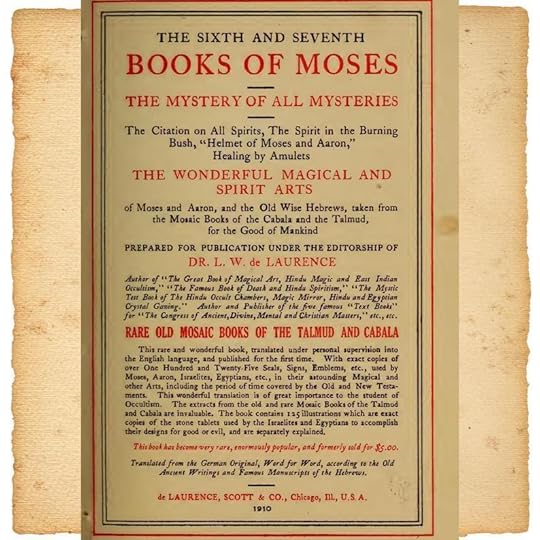 A recreation of the Seventh Book of Moses
A recreation of the Seventh Book of Moses“…the Seventh Book of Moses, which, I soon found, was a curious rigmarole of chants and incantations to such “princes” of the nether world of Aziel, Mephistopheles, Marbuel, Barbuel, Aniquel, and others.”
Yet another reason why we know this is emphatically not Lovecraft (besides the fact that Derleth was actually much better at dialogue). The Seventh Book of Moses is a real historical book which talks of magical and spiritual arts as well as Christian demons and devils and such and is commonly mentioned in occult circles. This is nothing like the Pnakotic Manuscripts or the Necronomicon. It’s a bit disappointing that we aren’t getting more of Lovecraft’s world, because Derleth claimed these stories were actually written by Howard Phillips and only cleaned up by Derleth. Like I said earlier, the stories (so far at least) stand on their own, but to put Lovecraft’s name on it gives the first tinges of stigma against Derleth. I still enjoyed the tale, but for these reasons it feels a bit like a cash grab instead of honest inspiration.
We then get another “Colour out of Space” reference when a Whippoorwill calls. If you recall from that tale, the whippoorwill cries as an omen for ill to come. Shortly there after the deadly call there’s a knock at the door.
Stark goes to answer, but waits the few minutes until after the clock strikes midnight… or at least he thinks he does:
“I heard Stark’s exclamation of triumph. ‘Past midnight!’ He had looked at his clock, and at the same time I looked at my watch. His clock was ten minutes fast.“
And retribution come right quick. Wentworth had come back for Stark.
“Amos Stark was spread on the floor on his back, and sitting astride him was a mouldering skeleton, its bony arms bowed above his throat, it’s fingers at his neck.“

Once the deed is done and Stark is dead the skeleton withdraws, leaving our narrator aghast in horror, and we get our moment of Scary Stories to tell in the Dark:
“For as I bent above Amos Stark, ascertaining that he was indeed dead, I saw sticking into the discolored flesh of his neck the whitened finger bones of a human skeleton, and, even as I looked upon them, the individual bones detached themselves, and went bounding away from the corpse, down the hall, and out into the night to rejoin that ghastly visitor who had come from the grave to keep his appointment with Amos Stark!”
Join me next week as we dive deeper into Derleth with hopeful curiosity in “The Peabody Heritage.”
April 8, 2021
Blind Read Through: H.P. Lovecraft/August Derleth; The Survivor
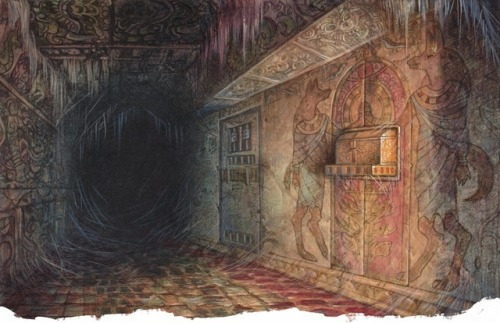
“The lower or ground floor, however, abounded in evidence of its one time occupant, the surgeon, for one room of it had manifestly served him as a laboratory of some kind, and an adjoining room as a study, for both had the look of having been but recently abandoned in the midst of some inquiry or research, quite as if the occupation of the house by its brief tenant – post mortem Charriere – had not touched upon these rooms.”
Welcome back to another Blind Read! We’ve graduated from Lovecraft after reading his entire catalog, and we’re now moving onto works inspired by, and potentially even partially written by, Lovecraft. August Derleth was one of Howard Phillip’s contemporaries and loved his work so much that he published it all years after they originally appeared in magazines like “Weird Tales.” From what I can surmise, Derleth states that much of what he wrote himself was based upon extensive notes he gathered from Lovecraft himself and thus for many years published these under Lovecraft’s name instead of his own.
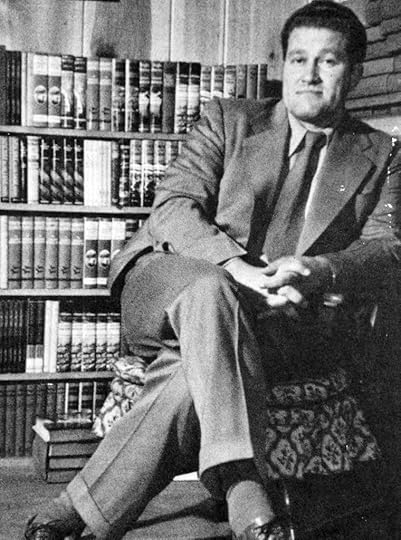 The un-assuming visage of August Derleth
The un-assuming visage of August DerlethThe Survivor is the first of these stories we’re getting to, and where the atmosphere, tone, and content are accurate and reminiscent of Lovecraft’s works, the writing makes it painfully apparent that this story was written by someone other than Lovecraft himself. Not to say that it’s bad. This is an entertaining story and it’s written well, but the archaic sentence structure and unique verbosity of Lovecraft created the depth of gothic horror present in all of his tales. This story feels more like Derleth is doing his best to imitate Lovecraft all while trying to clarify the mythos and put his own stamp onto it at the same time.
The story begins much like you’d expect; with out narrator recanting a story of something which happened in his past. We get that same “gather around the fireplace” feel but, again, you can tell right from the start that it isn’t Lovecraft writing:
“I had never intended to speak or write again of the Charriere house, once I had fled Providence on that shocking night of discovery – there are memories which every man would seek to suppress, to disbelieve, to wipe out of existence – but I am forced to set down how the narrative of my brief acquaintance with the house on Benefit Street, and my precipitate flight there-from, lest some innocent person be subjected to the indignity by the police in an effort to explain the horrible discovery the police have made at last – that same ghastly horror it was my lot to look upon before any human eye – and what I saw was surely far more terrible that what remained to be seen after all these years, the house having reverted to the city, as I had known it would.”
Wow! What a rambling full paragraph sentence which says absolutely nothing! The story really gets much better from here, but you can tell that Derleth was trying his hardest to do what Lovecraft did so well…create a thesis for the story in the first paragraph, to set the story up for what we should be expecting for the rest of our reading experience, but Derleth rambles here and it halts the suspension of disbelief due to lack of comprehension.
Soon Derleth rights his ship and we find that our protagonist/narrator is an “antiquarian” much like many of the Lovecraftian characters (think Charles Dexter Ward) and is looking for a house to live in for a month so he can continue his work. He is drawn to this house because of it’s old architecture, which delights his antiquarian nature despite having many people telling him the house is cursed.

He moves in finds that it’s the house of a Dr. Cherriere who recently died, but paid the taxes long enough so that one of his “relatives” could come and claim it (Though we already know from the opening paragraph that, that didn’t happen).
The house was built back in 1704 and “Its rooms were irregular – appearing to be either quite large or very small.” There is even a laboratory, which doesn’t surprise our narrator because Cherriere is a doctor, but in this lab there are “strange, almost cabalistic drawings, resembling physiological charts, of various kinds of saurians...”
This was the first moment that gave me pause (at least in terms of mythology). I was expecting a purely Lovecraftian fever dream out of this story, but it turns out that this is the first moment that Derleth decides to add his own spin onto Lovecraft’s mythos. There is evidence of other reptilian creatures and studies throughout the house and in the study the narrator finds, “a sequence of cryptic references to certain mythological creatures, particularly one named ‘Cthulhu,’ and another named ‘Dagon.'”
 Artist’s rendition of a Deep One
Artist’s rendition of a Deep OneObviously Derleth found these two gods and their servants, “The Deep Ones,” the most intriguing (at least as far as this first story is concerned. The evidence is there, however, because where Lovecraft called his mythology Yog-Sothothery, Derleth renamed it “The Cthulhu Mythos”), because this story is firmly rooted around the two of them. The change comes with the advent of the saurian features. The narrator calls the Deep Ones “evidently amphibious creatures living in the depths of the seas.” Which is curious for a number of reasons. The first is that amphibians don’t actually live deep under water as they need oxygen periodically. The second is that Lovecraft’s deep ones were fish creatures, not reptile creatures. So as Derleth is working on clearing up some of the confusion as to what these gods are and where they land in the pantheon, he is also stamping his own predilections on top. I’m in no way detracting from Derleth’s efforts (except for the amphibian living on the bottom of the ocean) because I believe that Lovecraft wanted other authors to take the ideas and run with them (he’s said so a few different times in letters). In fact the only reason Lovecraft is as popular as he is today is because of Derleth’s efforts at clarifying the mythos (and renaming it) for the broad populace. After reading just this first story, I myself have a much clearer understanding of the mythos which is, incidentally, what I was looking for when I started this series in the first place. It’s also why I wanted to keep going and cover Derleth as well. I believe Lovecraft was only looking to create unique and terrifying stories. It doesn’t seem like it was until Derleth took over that it really became a contained “cosmic horror” theme in and of itself.
 From the pages of the Pnakotic Manuscripts
From the pages of the Pnakotic ManuscriptsSpeaking of “mythos,” our narrator continues to dig and finds strange books which will be familiar to any reader of Lovecraft: Cultes des Goules, Unaussprechlichen Kulten, and The Pnakotic Manuscripts, all mixed in with other strange books of Derleth’s creation. Some of these (like The Saurian Age) will be interesting to see if they come up in future works as well, since it looks like Derleth is making the sea creatures reptilian, rather than the fish people of Innsmouth, potentially in an effort to make the Deep Ones more scary. He’s even moving from the notorious “smell” which we have found in Lovecraft to be a fungoid smell, to now a reptilian smell (full disclosure. I really have no idea what a reptilian smell is…can someone describe that? Is that in any way similar to the moldy smell of fungous?)
While filtering through these he finds that Dr. Cherriere is actually extremely old. There’s evidence of him being born back in the 1600’s! Could this actually be him and not just some ancestor? Could it be that he is actually not dead, and just waiting for the memory of his “death” to die down so he can come back as his own “nephew?” (Of course he is!)
This is where the real horror of the story begins. The narrator hears a break in and follows the sounds to the study:
“I turned on the flashlight, which was directed at the desk I had left…What I saw was incredible, horrible. It was not a man who stood there, but a travesty of a man.“
It was a half reptile, half man. It was Dr. Cherriere. The man who’d spent his life studying the ancient and forbidden knowledge hidden in those terrible books. It’s the classic Lovecraftian theme of the eternal desire to gain forbidden knowledge. Dr. Cherriere had turned himself, through experiments with the saurian nature of Dagon and Cthulhu and the hidden knowledge in the forbidden tomes, into a mockery of a man just to prolong his life.
The story is predictable, but in a weird way that’s comforting. Like I said earlier, this story feels like Derleth’s effort to clarify Lovecraft, and that predictability was necessary because he was giving the reader familiarity (or fan service?) so he could go the extra mile with exposition and explanation of known quantities. In general we know these creatures and those ancient tomes exist in this world…what we don’t know is how they’re interconnected. It almost feels like Derleth’s stories will be an approach of connecting Lovecraft’s world, instead of just writing horror stories.
Let’s find out if that’s the case next week, as we evaluate “Wentworth’s Day!”
Post Script:
If there is any doubt whether this was Lovecraft writing or Derleth, then rest easy. I found the smoking gun! The text should be enough to tell. Though Derleth is a good writer, his style is all together simple when put up next to Lovecraft. Lovecraft uses archaic words that weren’t even still in use back when he was writing in the 20’s and 30’s. He did this to give an “antiquarian” feel for the reader. To bring us all into a different world. Derleth isn’t looking to do that, he’s looking to clarify the universe in which Lovecraft created.
But that isn’t the smoking gun. I know, without a shadow of a doubt, that Derleth wrote this story and not Lovecraft because of a simple tool. Derleth calls it a flashlight. Lovecraft calls it a torch. There is not one mention of the word flashlight in any of Lovecraft’s stories. This is done on purpose to give the reader that previously mentioned feel. Derleth gives himself away, but really…do we care??
April 1, 2021
Blind Read Through: H.P. Lovecraft; The Shadow Out Of Time, Conclusion
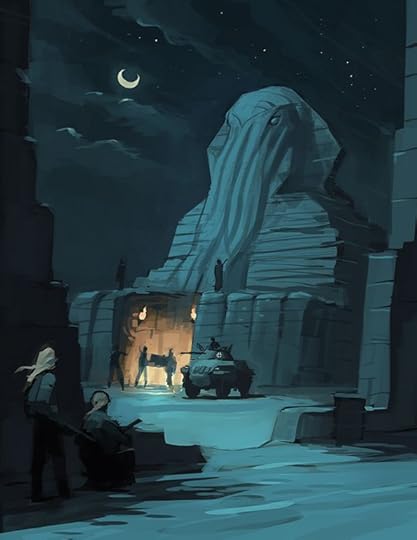
“If that abyss and what it held were real, there is no hope. Then, all too truly, there lies upon this world of man a mocking and incredible shadow out of time. But mercifully, there is no proof that these things are other than fresh phases of my myth-born dreams. I did not bring back the metal case that would have been proof, and so far those subterrene corridors have not been found. If the laws of the universe are kind, they will never be found.“
Welcome back to another Blind Read! This week is all about catharsis as we conclude the final story Howard Phillips wrote by himself, before diving into the handful of stories August Derleth co-wrote (or maybe ghost wrote) with Lovecraft. This was the perfect story to leave for last, as the quote above indicates and sums up the multi-year long project I’ve undertaken. Lovecraft himself was a Shadow out of Time, darkening our doorsteps with new horrors which cannot quite be seen but can be sensed and felt with the weight of eternity, the weight of history, and the weight of mythology.
Lovecraft moved his story beyond pointed philosophical treatises to an all out adventure with a narrative hurtling forward like an out of control semi flying downhill without brakes…and yet there is no grand reveal. Lovecraft does what he always does and lets the atmosphere play the role of terrorizer and he lets you know this right up front: “I cannot hope to give any true idea of the horror and dread contained in such echoes, for it was upon a wholly intangible quality – the sharp sense of pseudo-memory – that such feelings mainly depended.“
The story begins with a letter to our protagonist Professor Peaslee about an archaeological find of some strange stone and architecture in Australia. “They are mostly sandstone and granite, though one is almost certainly made of a queer sort of cement or concrete. They bear evidence of water action, as if this part of the world had been submerged and come up again after long ages – all since these blocks were made and used.”
Immediately we’re drawn back to “The Call of Cthulhu” and the great lost city of the Elder Gods, but more specifically the titular Cthulhu…R’lyeh. In that other story we are presented with a lost city found off the coast of Australia in the Indian Ocean. The city had architecture that was queer and somehow both convex and concave at the same time. The city which was lost to time under the sea. Now, here, in Australia we find evidence that “part of the world had been submerged and come up again after long ages.” We know that this is on landlocked Australia, so it more than likely is not part of R’lyeh, however it is undoubtedly part of that same civilization.
So what does Professor Peaslee do? He gathers a group of scientists, including Professor William Dyer of Miskatonic University. Does that name sound familiar to you? Well that’s because this is the Professor who went on the Antarctic Expedition in “At the Mountains of Madness,” where I personally was introduced to the Shoggoth.
Again, it seems like Lovecraftian synergy that all of these stories come to bear in this last novelette. This series is truly Blind, meaning that I always loved the concepts of Lovecraft, but had never actually read him. I was always daunted by the language, so I’ve started many times, but never followed through. I decided that the only way to keep me honest and finish these stories was to do an academic exercise and deconstruct the stories and look for the narratives. I knew there was a Dream Cycle, I knew there were gothic horror stories, I knew there was the Mythos, but I didn’t know which story was which, so I randomly picked a jumping off point and went into them. Similarly, as I traversed through his oeuvre I didn’t know which story to read, so I chose them based upon length and how much time I had in that given week to be able to honestly read, digest, and compose an essay. The fact that all of these stories are converging (and believe me the denouement of this story feels just like “The Beast in the Cave“) into this single story, my last story, just solidifies my adoration of the process and of the author.
Some of Lovecraft’s best writing comes in the last chapter of this story, and though it doesn’t have the shocking ending that he was truly going for, it brings the feeling of the two different halves of the story together, much like it brings together the true forms of Lovecraft’s writing.
The crew goes on expedition and begins their dig in the Australian Desert. Our narrator felt a “Strange sense of compulsion” and goes off to find a “Cyclopean tunnel” which leads down into the earth. The description is reminiscent of the tunnels in “At the Mountains of Madness” and is in fact the only real depredation I have for this story. We never get to see Dyer do anything, but we know he has first hand knowledge of this architectural structure.
 The Strange other-worldly architecture of Lovecraft’s Mind
The Strange other-worldly architecture of Lovecraft’s MindBeyond this there are some excellently written horror scenes, where Peaslee traverses down into the depths of this ancient alien sub-world and has vague memories of seeing the glyphs on the stones. In addition he seems to have knowledge of which way to go to find the evidence he’s looking for. Throughout the whole descent there is a terribly oppressive feeling of anxiety. Peaslee somehow knows that he must remain quiet, he knows that there’re sleeping giants down in the depths and he knows that he must be quick and silent – or he will never return from this venture. Some great creature which, “I thought of that which the Great Race had feared, and of what might still be lurking – be it ever so weak and dying – down there.”
Strange feelings of knowledge and memory keep assaulting Peaslee until he finally finds what he’s looking for. It’s a tome of ancient knowledge:
“At length I tremblingly pulled the book from it’s container and stared fascinatedly at the well-known hieroglyphs on the cover. It seemed to be in prime condition, and the curvilinear letters of the title held me in almost as hypnotized a state as if I could read them. Indeed, I cannot swear that I did not actually read them in some transient and terrible access of abnormal memory.”
He then takes the book and flees, but makes a critical mistake, “Just as I blindly crossed the summit, unprepared for the sudden dip ahead, my feet slipped utterly and I found myself involved in a mangling avalanche of sliding masonry whose cannon-loud uproar split the black cavern air in a deafening series of earth shaking reverberations.”
He had woken the beast, or beasts. “I have a dim picture of myself as flying through the hellish basalt vault of the Elder Things, and hearing that damnable alien sound piping up from the open, unguarded door of limitless nether blacknesses.”
He then comes to a rift which he must traverse, but to jump up is far worse that jumping down. He doesn’t think he can make it, but at the same time he can almost feel the Elder Thing at his heels. The howling and whistling of the demonic metropolis seem to come from all directions, so he decides that there’s no way out. He must jump…but he doesn’t make it:
The I saw the chasm’s edge, leaped frenziedly with every ounce of strength I possessed, and was instantly engulfed in a pandaemoniac vortex of loathsome sound and utter, materially tangible blackness.
While in this state of utter blackness he seems to fall into a dream, “Afterward there were visions of the Cyclopean city of my dreams – not in ruins, but just as I had dreamed of it. I was in my conical, non-human body again, and mingled with crowds of the Great Race and the captive minds who carried books up and down the lofty corridors and vast inclines.“
Sounds familiar? We even get the last line of the story to solidify what’s really happening here: “And yet, when I flashed my torch upon it in that frightful megalithic abyss, I saw that the queerly pigmented letters on the brittle, aeon-browned cellulose pages were not indeed any nameless hieroglyphics of earth’s youth. They were, instead, the letters of our familiar alphabet, spelling out the words of the English language in my own handwriting.“
This dream, this time-lapse, this dimension, is all interconnected. Peaslee spent his five lost years travelling around in the body of one of the Great Race of Yith, and he transposed horrific texts, of which he found in an aeon lost structure of the Elder Ones, buried somewhere underneath the sands of Australia. This proves the interconnectedness of Lovecraft’s universe in such a wonderful way, and is such a spectacular endpoint to his actual writing.
Reminiscent of “The Tomb”Lovecraft has four different styles. His satirical humor, which are one off stories. His Gothic horror, which are what they sound like, however they do interconnect with his Cosmic horror stories, they just have a more visceral, a more, well, horrific bent. The Mythos stories, or the Cosmic stories, tend to have a much more psychological horror element to them. Finally the Dream Cycle tends to be more adventurous. Those are the styles, but that’s what makes it so good, because with this story it’s readily apparent that all of his tales have some interconnectedness. Everything here happens in Lovecraft Country and Lovecraft Country is his own alternate world where this can all happen!
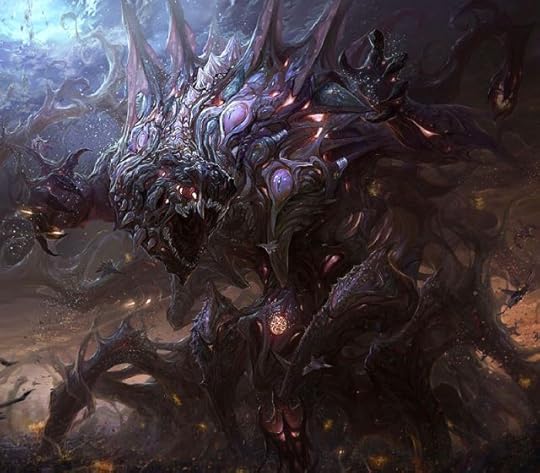 The Blind Idiot God Azathoth
The Blind Idiot God AzathothThe Dreamers (like Randolph Carter) are actually dimensional hoppers and there’s a multiverse here in which they traverse time by sidestepping physics and jumping to whatever reality is needed. Whether that’s sailing through the galaxy with Azathoth, or grave robbing with buddies, the dreamers have this special ability to let the horror of the scope of the cosmos wash over them and allow them to experience this amount of cosmic horror thus making those stories more like adventures. Individuals exploring the great wide open. The characters who don’t have the mental capacity to deal with these realities enter the cosmic horror tales, which focus on madness, but in reality we get very few tentacles.
So this makes me wonder where the cultural consciousness came to the idea that Lovecraft had to have some kind of creature with tentacles, since while reading, you can probably count on two hands how many stories actually mention a character viewing a monster, and on one hand where you actually are given a description of what they see.
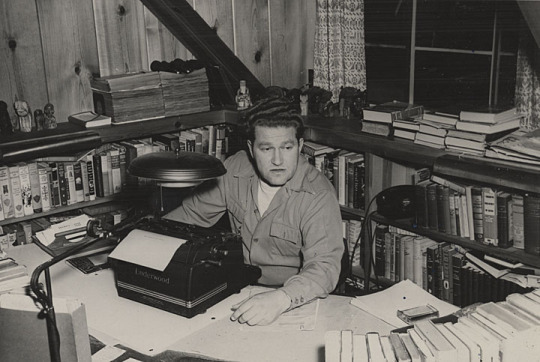 August Derleth in his writing corner
August Derleth in his writing cornerAugust Derleth was one of Lovecraft’s friends (and publishers) and he was the one to coin the phrase “Cthulhu Mythos” where Lovecraft preferred to call it Yog-Sothothery. So one has to wonder…was it Derleth that created this monstrous concept of what it was like to be “Lovecraftian?” I’ve never read him, so I’m not sure.
Why don’t we find out?
Join me next week as we read our first August Derleth writing as H.P. Lovecraft, “The Survivor!”



